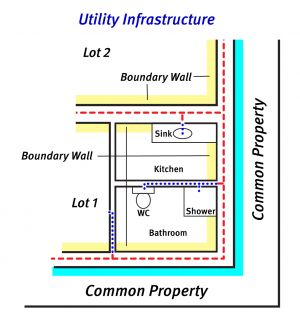Utility infrastructure maintenance
Utility infrastructure are the pipes, cables, wires, sewers, drains, plant and equipment supplying a utility service to the lots or the common property in a community titles scheme.
Utility services include:
- water, gas or electricity supplies
- air conditioning
- telephone, data or television services
- drainage
- waste disposal
- a sewer system.
It can also be another system or service designed to benefit a lot or common property.
Utility infrastructure and common property
The body corporate is usually responsible for utility infrastructure that is part of common property.
If the utility infrastructure is not part of common property, the lot owner is generally responsible for maintaining it.
All utility infrastructure in a community titles scheme is part of common property except for utility infrastructure that:
- supplies a utility service to only 1 lot
and
- is within the boundaries of the lot
and
- is not within a boundary structure for the lot.
A boundary structure for a lot in a scheme means a floor, wall or ceiling, other than a false ceiling, which serves as the boundary of the lot with another lot or common property. This definition applies to all schemes regardless of the plan of subdivision.
It is important for both the body corporate and lot owners to understand the boundaries of lots and know if utility infrastructure is part of common property.
Building format plan
This diagram gives an example of utility infrastructure responsibilities in a building format plan.


The body corporate is responsible for the cold-water pipes or cables shown as dashed lines (red) in this diagram as they are located within a boundary structure.
The lot owner is responsible for:
- The cold-water pipes or cables shown as dotted lines (blue) as they service 1 lot only and are located within an internal wall (not a boundary structure).
- A hot water system, including the associated pipes and wiring, supplying the service solely to the lot, even if the system is on common property.
- An air-conditioning system including the associated pipes and wiring, supplying the service solely to the lot, even if the system is on common property.
- Solar panels including the associated pipes and wiring, supplying the service solely to the lot, even if the system is on common property.
- Television antennae including associated wiring, supplying the service solely to the lot, even if the antenna is on common property.
Standard format plan
This diagram gives an example of utility infrastructure responsibilities in a standard format plan.


The body corporate is responsible for the:
- Water pipes or cables shown as dashed lines (red) as they supply the service to more than 1 lot.
- Guttering and associated downpipes shown with the solid (pink) spanning 2 lots (1 and 2 and 3 and 4) supplying a service to more than 1 lot.
- Any television antenna that services 2 or more lots.
The lot owner is responsible for the:
- Water pipes or cables shown as dotted lines (blue) as they are located within the lot boundary and service 1 lot only.
- Guttering and associated downpipes shown as solid shading above lot 7 (brown).
See body corporate maintenance for more information on scheme boundaries, common property and lots.
Exclusive use by-laws
Exclusive use by-laws cannot give exclusive use rights to utility infrastructure that is part of common property.
For more information see:
- section 177 of the Body Corporate and Community Management Act 1997
- exclusive use by-laws.
When different rules apply
In some cases a lot owner (or occupier) can be responsible for maintenance even if the items are on common property or outside their lot.
This can include:
- Utility infrastructure (including equipment and associated wiring and pipes) on common property that only services 1 lot and is for a hot water system, washing machine, solar panel, clothes dryer, air conditioner, television antenna or similar equipment.
- A shower tray even if it is not inside the lot.
- Utility infrastructure that is installed on common property by an occupier for the occupier’s benefit.
A meter installed to measure water supplied to a community titles scheme may remain the property of the provider supplying the water, and will not be part of common property. This applies to meters installed in schemes established after 1 January 2008.
Utility infrastructure installed under an agreement with the original owner (i.e. the developer) or the body corporate (e.g. cable television equipment), may remain the property of the service provider. It will only be part of common property if ownership is transferred to the body corporate under the terms of the agreement.
How utility services are charged
When lots are individually metered, owners can be charged based on their actual usage. The body corporate may take on the liability for the total cost of the service and then levy owners, or they may be charged directly by the provider for services such as water, gas and electricity.
When there is no realistic way of measuring the usage by individual lots, the body corporate will levy owners based on the contribution schedule lot entitlements, or share the cost equally between the owners of each lot.
The owners of each lot also contribute to the common property portion of the utility service provided. This is based on the contribution schedule lot entitlement.


